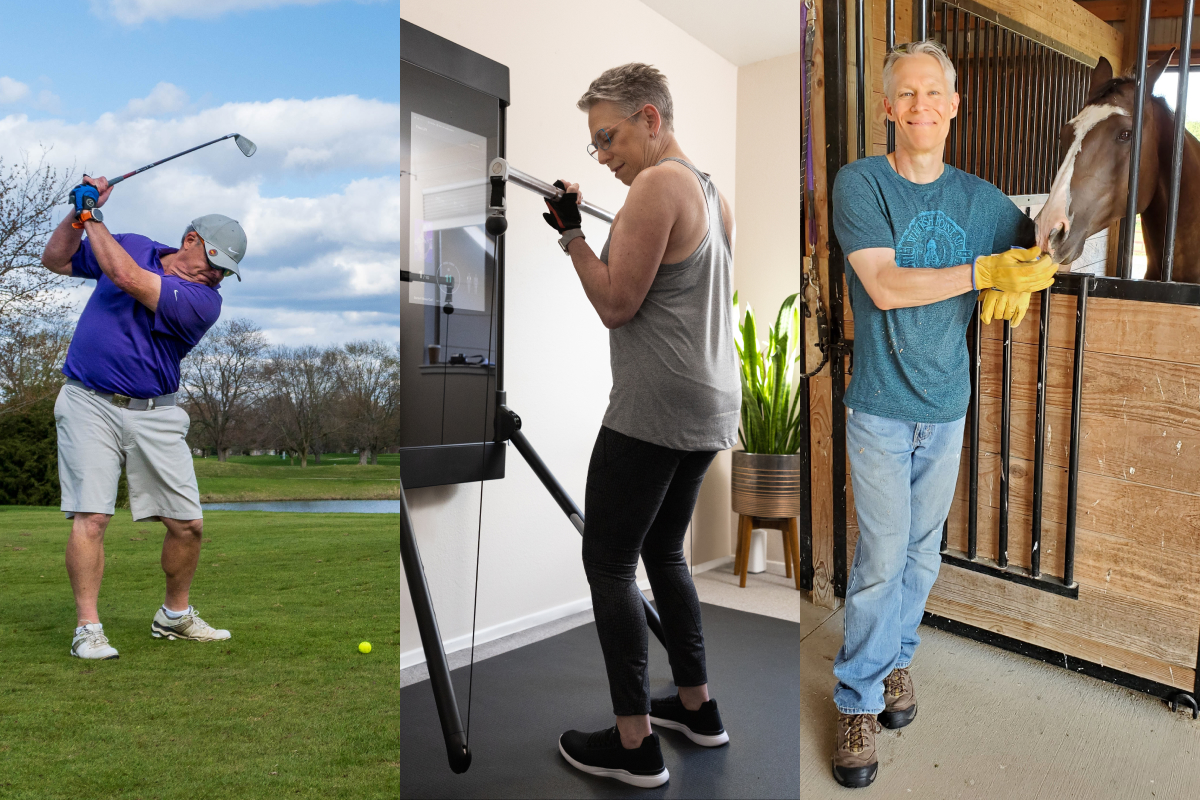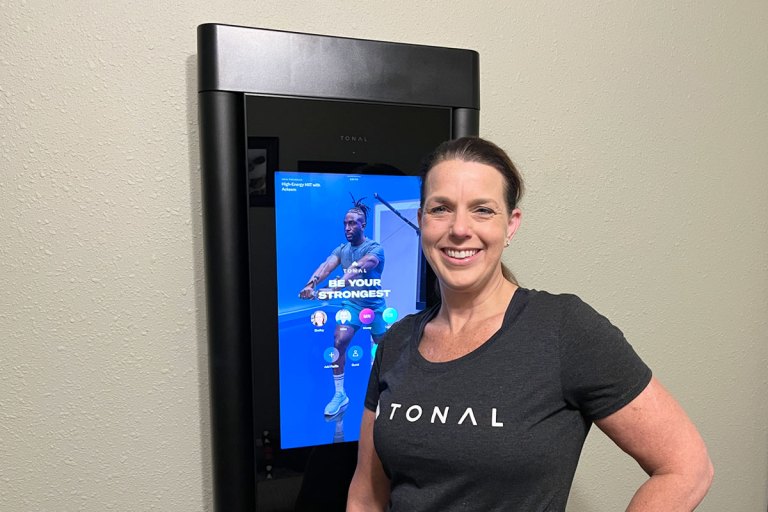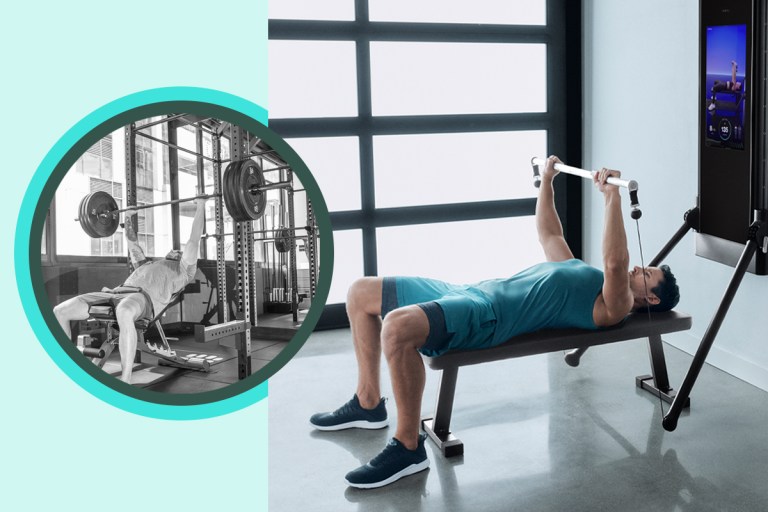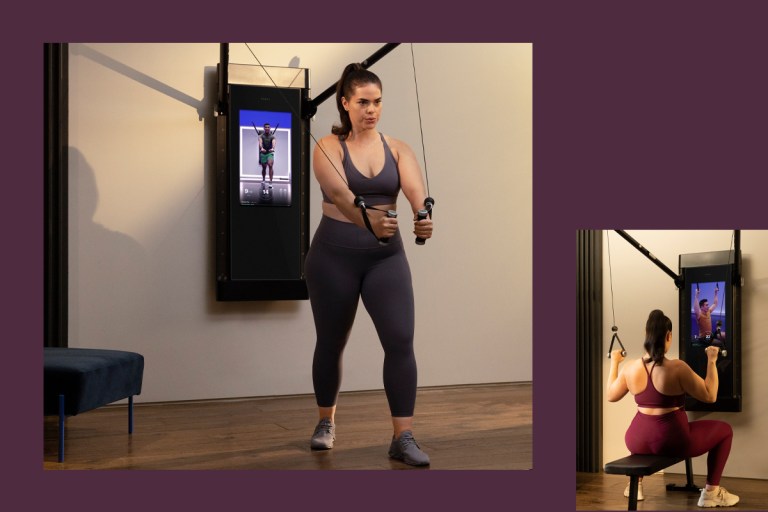What Are Non-Scale Victories and How Can They Motivate Your Training?
9 ways to measure the success of your fitness journey that have nothing to do with your weight.

Since fitness means different things to different people—from hitting a deadlift PR to recovering from knee pain so you can chase after your kids—it doesn’t make sense for everyone to use the same metric to gauge their success. And yet, when you’re on a fitness journey it’s easy to get stuck on a single number: your weight on the scale.
Your weight only shows a small sliver of the larger picture, and fluctuates based on the day of the week, hydration levels, and hormonal changes. Seeing these ups and downs can be discouraging if you’re only using one number to track your progress. Additionally, when your goal is body recomposition (gaining muscle and losing fat) it’s possible to make significant improvements without seeing the number on the scale shift.
Tonal members know that celebrating non-scale victories can make your fitness journey much more fun. Get inspired by their strategies for charting your transformation.
1. Progress Photos
When looking at your own body in the mirror every day it’s hard to notice subtle changes, so you might be surprised if a friend or family member who you haven’t seen in months compliments you on looking strong and lean. To get a better sense of these long-term changes for yourself, try taking photos of yourself at regular intervals, such as monthly or quarterly.
Tonal member Jessica Calixto was feeling discouraged when she only lost one pound after lifting regularly for eight weeks. It wasn’t until she compared a current photo of herself to one she took at the start of her workout routine that she realized how much progress she had made. “My body looked much more toned with more visible muscle,” she says. “Seeing that picture even without a huge weight drop showed me that change is happening and consistency works.”
2. How Your Clothes Fit
Even if your weight doesn’t drop, shifting your body composition by gaining muscle and losing fat can change your appearance, and is one of the most motivating non-scale victories. That’s because muscle is denser than fat and a pound of muscle takes up less space in your body than a pound of fat. You’ll likely notice these changes when you try on clothes and discover that pants or shirts that used to be too tight are now loose.
Police officer Joseph Mapa was motivated to buy Tonal and start working out when he realized his uniform pants were getting too small. He had to order the next size up, but hoped he wouldn’t have to wear them. After seven months of working out on Tonal, he not only never needed those bigger pants, he’s had to make the belt on his current size a few loops tighter.
3. Measurements
Similar to the way your clothes fit, taking measurements can gauge your progress in terms of body composition. This can be as simple as using a tape measure to track the circumference of your hips, waist, and thighs, or using skinfold caliper testing to measure subcutaneous fat. Since muscle takes up less room than fat, you’ll see the measurements dropping as you improve your body composition.
Measurements can also show if you’re actually putting on muscle, which isn’t reflected on the scale. Tonal member Jeffrey Levy uses his tape measure to track his impressive gains, which he didn’t expect to see into his 60s. “I started taking measurements when I began working out on Tonal, and I’ve gained two inches in my chest, over an inch in my biceps, and three inches in my shoulders,” he says “At my age, I’m extremely happy with those results, because I don’t have the same level of muscle-building hormones a 25-year-old has.”
4. Strength
One of the most obvious perks of starting resistance training is quickly seeing gains in your strength. Suddenly, you’re confidently cranking out reps with 10-pound weights when 5-pound biceps curls seemed difficult a mere month ago. On Tonal, you’ll be able to see these gains in your Strength Score, a proprietary metric that tracks your overall strength by estimating your one-rep maxes in different exercises. And, if you repeat the same workout or program, Tonal will show you how much you lifted the second time compared to the first.
The benefits of getting stronger go far beyond lifting heavier weights. For one, you’ll feel more capable and independent in your everyday life. Plus, higher levels of strength were associated with a lower risk of death from all causes in a meta-analysis of studies that included nearly two million adults. Another review of studies found that older people who regularly strength train have improved overall function and ability to do daily tasks.

5. Milestones, Streaks, and PRs
Keeping track of your workout stats can be very motivating as it helps you see how far you’ve come. When you’re on a 10-week workout streak, it’s likely you’ll want to keep going and not break your streak. The more consistent you currently are with your workouts, the more likely you are to stay consistent over time. New exercisers who started working out four times per week for six weeks were more likely to stick with their habit than those who were less consistent, according to one study.
Tonal tracks all these metrics for you: weekly workout streaks, total volume lifted, total workouts, volume history for each move, and personal records for strength, power, and volume. For Tonal member Arlene Kraushaar, all these numbers are a source of pride—and a sign of her incredible progress. Kraushaar recently hit a milestone, lifting three million pounds total, and has a streak of over 120 workout weeks. These non-scale victories have left her incredibly proud.
6. Mood
Finishing a tough workout can leave you feeling like you’re on top of the world, and there’s evidence that exercise’s mood-boosting power lasts long after your final rep. Feeling happier and less anxious are proven benefits of strength training. Recent research has even shown eight weeks of consistent strength training reduced symptoms of depression. Noticing a lift in your mood can signify that you’re being consistent with your workouts.
Take Tonal member Troy Moppin: Moppin started his fitness journey to lose weight and get in shape but noticed a huge improvement in his mood along the way. “People at work started to notice that my attitude and presence improved,” he said. “I realized I was becoming happier, enjoying doing things more, and taking on more challenges.”
7. Sleep
Struggling to fall or stay asleep puts a damper on your daily mood and energy levels. If you recently started an exercise routine and notice you’ve been sleeping better, it’s not a coincidence. It’s one of many non-scale victories. In a 2022 study, participants who previously slept fewer than seven hours per night saw a 40-minute increase in average sleep time after 12 months of a strength training program. This increase was even more dramatic than the 23-minute average seen among participants who did aerobic exercise instead.
Exercise can also alleviate conditions that make sleeping more difficult or uncomfortable. Before he became a Tonal member, Robert Mahaney suffered from sleep apnea and had to sleep with a CPAP machine to help him breathe at night. Within a year of working out consistently on Tonal, Mahaney stopped needing his CPAP machine and started sleeping more soundly.
8. Athletic Performance
Even if you’re not a professional athlete, you likely want to feel your best and perform better in your favorite activity, whether that’s running, cycling, golf, or pickup basketball. Besides helping you achieve aesthetic goals, strength training improves your power, agility, and stability, all skills that will help you run faster, throw farther, and play harder.
With the strength and power they gained in their workouts, Tonal members feel more confident in all their activities and adventures. Jeffrey Levy is playing the best golf of his life—after training on Tonal, he added 30 yards to his drive. Tracy Dingman, also in her 60s, credits Tonal for the mobility and endurance that allows her to keep hiking the world’s tallest mountains.
9. Less Pain
It’s normal for intense workouts to leave you with occasional sore or tight muscles, but when it comes to chronic pain, exercise is both an excellent treatment and preventative measure. Strength training in particular has been shown to improve osteoarthritis symptoms in older adults with knee or hip pain. A recent study with more than 20,000 participants uncovered a link between higher levels of physical activity and less chronic pain.
When Tonal member Ted Friedl moved from the city to a farmhouse in a rural town, he quickly realized he’d need to strengthen his knees if he wanted to keep up with his chores around the farm and stay pain-free. “The knee pain made it tough for me to do weekend projects on our property,” he says. After working out on Tonal for a few months, his knee pain disappeared and he now feels confident walking up stairs, climbing ladders, and weeding the garden without risking pain or injury.


